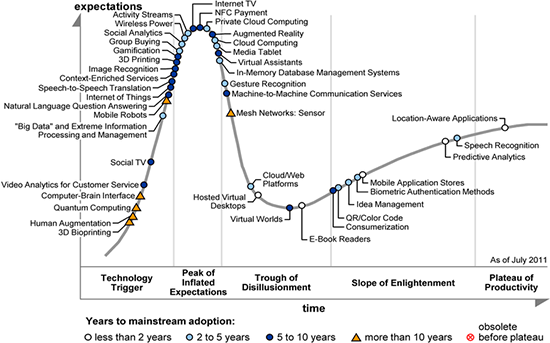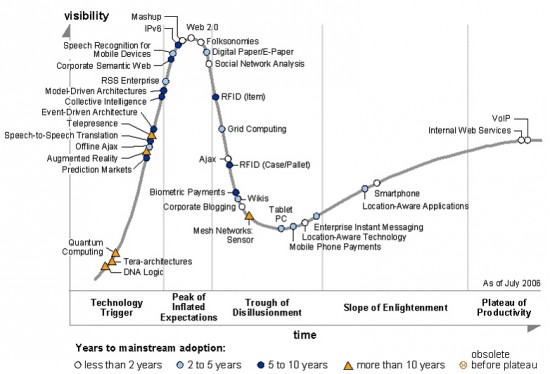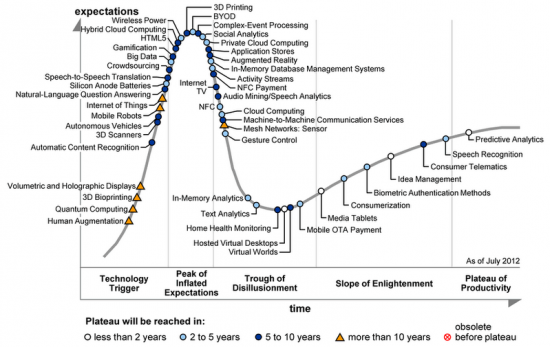С вертикальной осью графика всё понятно: это уровень ожиданий. Горизонтальная же разделена на шесть секторов: появление технической возможности, "пик завышенных ожиданий", "пропасть разочарований", "склон просвещения" и "плато продуктивности". Скорость преодоления этих этапов зависит от зрелости технологии.
Именно потому кружочки и треугольники раскрашены в разные цвета: белый означает, что технология может войти в нашу жизнь в ближайшие два года, голубой - от двух до пяти лет, синий - от пяти до десяти лет, жёлтый треугольник - более десяти лет. Красный кружок с крестиком - провалившиеся технологии, устаревшие быстрее, чем удалось добраться до плато продуктивности.
Вот свежий график.
На пике популярности оказались:
- краудсорсинг - сбор данных силами пользователей
- Big Data - тема связанная с data mining, то есть поиском закономерностей в больших объёмах данных
- геймификация - превращение рутинных занятий в игры (на эту тему мы публиковали подробную статью)
- HTML5
- гибридные облачные вычисления
- беспроводная энергия
- трёхмерная печать (в этом году свет увидел первый домашний 3D-принтер)
- BYOD - Bring Your Own Device, использование собственных компьютеров на работе. Ещё это называют "консюмеризацией IT"
- обработка сложных событий - выделение закономерностей из большого числа событий
- социальная аналитика
- приватные облачные вычисления
- магазины приложений
- дополненная реальность
- базы данных, работающие в оперативной памяти
По сравнению с прошлым годом с пика популярности скатилось интернет-телевидение, планшеты продвинулись аж до "склона просвещения", миновав "пропасть разочарования", activity streams (потоки пользовательских действий наподобие ленты Facebook) вообще пропали из вида, равно как и групповые покупки - прошлогодняя шумиха вокруг сервисов в духе Groupon закончилась ничем.

График Hype Cycle 2011 года
Среди технологий, подающих наибольшую надежду теперь числится трёхмерное сканирование, зато напрочь выбыло социальное телевидение и интерфейсы мозг-компьютер. Зато на горизонте появились голографические дисплеи.
На пик завышенных ожиданий вот-вот взойдёт машинный перевод голоса, нанопроводниковые аккумуляторы, поиск ответов на вопросы, заданные на натуральном языке (см. IBM Watson или ассистента Siri, встроенного в iPhone 4S), самоуправляемые автомобили, интернет вещей и мобильные роботы. Последние две технологии в Gartner считают реализуемыми не ранее чем через десять лет.
В том, что график Gartner не надуман, и действительно неплохо отражает реальность, можно судить, посмотрев отчёты за прошлые годы. Сейчас это может прозвучать удивительно, но ещё в 2009 году завышенные ожидания были связаны с электронными книгочиталками и микроблогами, в 2008 пик популярности только-только прошли твердотельные накопители, а в 2006 - вики и метки RFID, а "царём горы" тогда был Web 2.0.

График Hype Cycle 2006 года
Gartner's 2012 Hype Cycle for Emerging Technologies Identifies "Tipping Point" Technologies That Will Unlock Long-Awaited Technology Scenarios
2012 Hype Cycle Special Report Evaluates the Maturity of More Than 1,900 Technologies
STAMFORD, Conn., August 16, 2012-
Big data, 3D printing, activity streams, Internet TV, Near Field Communication (NFC) payment, cloud computing and media tablets are some of the fastest-moving technologies identified in Gartner Inc.'s 2012 Hype Cycle for Emerging Technologies.
Gartner analysts said that these technologies have moved noticeably along the Hype Cycle since 2011, while consumerization is now expected to reach the Plateau of Productivity in two to five years, down from five to 10 years in 2011. Bring your own device (BYOD), 3D printing and social analytics are some of the technologies identified at the Peak of Inflated Expectations in this year's Emerging Technologies Hype Cycle (see Figure 1).
Gartner's 2012 Hype Cycle Special Report provides strategists and planners with an assessment of the maturity, business benefit and future direction of more than 1,900 technologies, grouped into 92 areas. New Hype Cycles this year include big data, the Internet of Things, in-memory computing and strategic business capabilities.
The Hype Cycle graphic has been used by Gartner since 1995 to highlight the common pattern of overenthusiasm, disillusionment and eventual realism that accompanies each new technology and innovation. The Hype Cycle Special Report is updated annually to track technologies along this cycle and provide guidance on when and where organizations should adopt them for maximum impact and value.
The Hype Cycle for Emerging Technologies report is the longest-running annual Hype Cycle, providing a cross-industry perspective on the technologies and trends that senior executives, CIOs, strategists, innovators, business developers and technology planners should consider in developing emerging-technology portfolios.
"Gartner's Hype Cycle for Emerging Technologies targets strategic planning, innovation and emerging technology professionals by highlighting a set of technologies that will have broad-ranging impact across the business," said Jackie Fenn, vice president and Gartner fellow. "It is the broadest aggregate Gartner Hype Cycle, featuring technologies that are the focus of attention because of particularly high levels of hype, or those that Gartner believes have the potential for significant impact."
"The theme of this year's Hype Cycle is the concept of 'tipping points.' We are at an interesting moment, a time when many of the scenarios we've been talking about for a long time are almost becoming reality," said Hung LeHong, research vice president at Gartner. "The smarter smartphone is a case in point. It's now possible to look at a smartphone and unlock it via facial recognition, and then talk to it to ask it to find the nearest bank ATM. However, at the same time, we see that the technology is not quite there yet. We might have to remove our glasses for the facial recognition to work, our smartphones don't always understand us when we speak, and the location-sensing technology sometimes has trouble finding us."
Figure 1. Hype Cycle for Emerging Technologies, 2012

Source: Gartner (August 2012)
Although the Hype Cycle presents technologies individually, Gartner encourages enterprises to consider the technologies in sets or groupings, because so many new capabilities and trends involve multiple technologies working together. Often, one or two technologies that are not quite ready can limit the true potential of what is possible. Gartner refers to these technologies as "tipping point technologies" because, once they mature, the scenario can come together from a technology perspective.
Some of the more significant scenarios, and the tipping point technologies, need to mature so that enterprises and governments can deliver new value and experiences to customers and citizens include:
Any Channel, Any Device, Anywhere - Bring Your Own Everything
The technology industry has long talked about scenarios in which any service or function is available on any device, at anytime and anywhere. This scenario is being fueled by the consumerization trend that is making it acceptable for enterprise employees to bring their own personal devices into the work environment. The technologies and trends featured on this Hype Cycle that are part of this scenario include BYOD, hosted virtual desktops, HTML5, the various forms of cloud computing, silicon anode batteries and media tablets. Although all these technologies and trends need to mature for the scenario to become the norm, HTML 5, hosted virtual networks and silicon anode batteries are particularly strong tipping point candidates.
Smarter Things
A world in which things are smart and connected to the Internet has been in the works for more than a decade. Once connected and made smart, things will help people in every facet of their consumer, citizen and employee lives. There are many enabling technologies and trends required to make this scenario a reality. On the 2012 Hype Cycle, Gartner has included autonomous vehicles, mobile robots, Internet of Things, big data, wireless power, complex-event processing, Internet TV, activity streams, machine-to-machine communication services, mesh networks: sensor, home health monitoring and consumer telematics. The technologies and trends that are the tipping points to success include machine-to-machine communication services, mesh networks: sensor, big data, complex-event processing and activity streams.
Big Data and Global Scale Computing at Small Prices
This broad scenario portrays a world in which analytic insight and computing power are nearly infinite and cost-effectively scalable. Once enterprises gain access to these resources, many improved capabilities are possible, such as better understanding customers or better fraud reduction. The enabling technologies and trends on the 2012 Hype Cycle include quantum computing, the various forms of cloud computing, big data, complex-event processing, social analytics, in-memory database management systems, in-memory analytics, text analytics and predictive analytics. The tipping point technologies that will make this scenario accessible to enterprises, governments and consumers include cloud computing, big data and in-memory database management systems.
The Human Way to Interact With Technology
This scenario describes a world in which people interact a lot more naturally with technology. The technologies on the Hype Cycle that make this possible include human augmentation, volumetric and holographic displays, automatic content recognition, natural-language question answering, speech-to-speech translation, big data, gamification, augmented reality, cloud computing, NFC, gesture control, virtual worlds, biometric authentication methods and speech recognition. Many of these technologies have been "emerging" for multiple years and are starting to become commonplace, however, a few stand out as tipping point technologies including natural-language question answering and NFC.
What Payment Could Really Become
This scenario envisions a cashless world in which every transaction is an electronic one. This will provide enterprises with efficiency and traceability, and consumers with convenience and security. The technologies on the 2012 Hype Cycle that will enable parts of this scenario include NFC payment, mobile over the air (OTA) payment and biometric authentication methods. Related technologies will also impact the payment landscape, albeit more indirectly. These include the Internet of Things, mobile application stores and automatic content recognition. The tipping point will be surpassed when NFC payment and mobile OTA payment technologies mature.
The Voice of the Customer Is on File
Humans are social by nature, which drives a need to share - often publicly. This creates a future in which the "voice of customers" is stored somewhere in the cloud and can be accessed and analyzed to provide better insight into them. The 2012 Hype Cycle features the following enabling technologies and trends: automatic content recognition, crowdsourcing, big data, social analytics, activity streams, cloud computing, audio mining/speech analytics and text analytics. Gartner believes that the tipping point technologies are privacy backlash and big data.
3D Print It at Home
In this scenario, 3D printing allows consumers to print physical objects, such as toys or housewares, at home, just as they print digital photos today. Combined with 3D scanning, it may be possible to scan certain objects with a smartphone and print a near-duplicate. Analysts predict that 3D printing will take more than five years to mature beyond the niche market.

